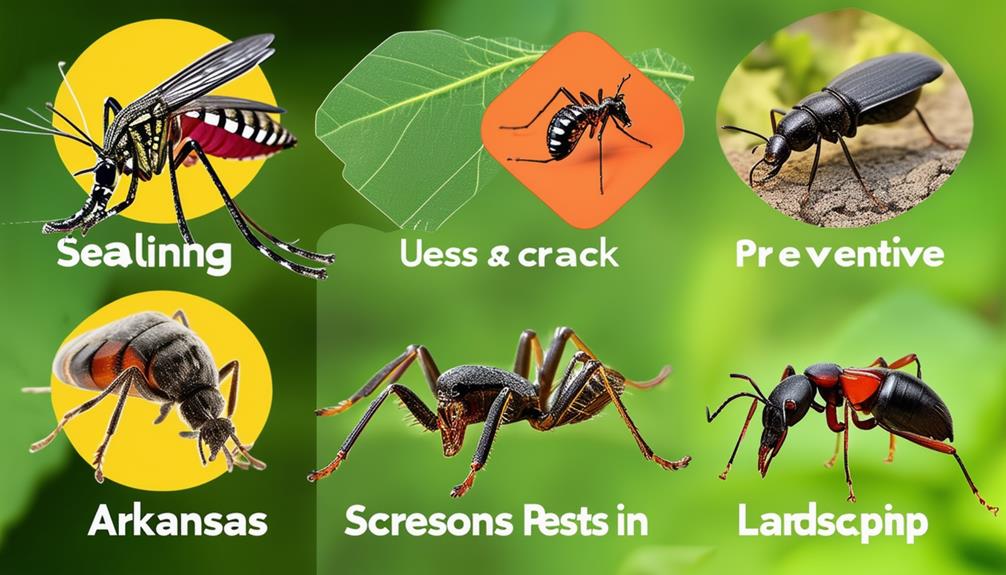As the seasons shift in Arkansas, so do the pests that come along with them. From termites in the spring to mosquitoes in the summer, each time of year presents its unique challenges. Knowing how to prepare for these seasonal invaders can make a significant difference in maintaining a pest-free environment. Stay tuned to discover practical tips and strategies to keep your home and surroundings pest-free throughout the year in Arkansas.
Key Takeaways
- Implement preventive measures like sealing cracks and using insecticides for spring pests.
- Use insect repellents, eliminate standing water, and maintain a tidy yard for summer pest prevention.
- Employ specific strategies like removing debris and sealing entry points for fall pest management.
- Seal cracks, maintain outdoor barriers, and focus on insulation for winter pest control.
- Utilize year-round monitoring techniques and outdoor pest-proofing to prevent infestations in Arkansas.
Common Spring Pests in Arkansas
Spring in Arkansas brings a variety of common pests that emerge during this season, including termites, queen wasps, moles, ants, spiders, and beetles.
Termites in Arkansas are particularly important in spring as they mate and establish new colonies, often infiltrating homes through cracks and openings. It's vital to implement proactive pest control measures to prevent termite infestations and subsequent structural damage.
Additionally, queen wasps in Arkansas begin forming colonies and constructing nests during the spring season, highlighting the significance of early intervention to mitigate wasp populations.
Moles also exhibit peak activity in early spring in Arkansas, necessitating the identification of infestation signs and the utilization of available repellent solutions for effective pest management.
Moreover, the anticipation of emerging ants, spiders, and beetles underscores the need for preventive actions and potentially seeking professional pest control services to address these insect pests promptly.
Spring serves as a critical period for implementing thorough pest control strategies to safeguard against termites, wasps, moles, and other common pests in Arkansas.
Summer Pest Prevention Tips
During the summer months, it's important to implement effective pest prevention measures to combat seasonal invaders.
To manage household pests in Arkansas during this season, consider the following tips:
Implement insect repellents and traps to control mosquitoes and ticks, which are prevalent during summer.
Regularly inspect and eliminate any standing water in your yard to prevent mosquito breeding grounds.
Additionally, keeping your lawn well-maintained is vital to reduce hiding spots for stinging insects like wasps and bees.
Utilize natural repellents or professional pest control services to deter carpenter ants that are active in the summer.
Stay alert for signs of common summer pests such as ants, flies, spiders, and stinging insects, and take preventive actions promptly.
Fall Pest Management Strategies
As the summer season gives way to fall, it becomes essential to shift focus towards implementing effective pest management strategies to combat seasonal invaders in Arkansas. During the fall, pests like Asian Multicolored Lady Beetles, Box Elder Bugs, Brown Marmorated Stink Bugs, and Cluster Flies become more prevalent. Implementing control measures is vital to prevent allergic reactions and nuisance infestations. Below is a table outlining specific fall pest management strategies for these common pests:
| Pest | Management Strategies | Characteristics |
|---|---|---|
| Asian Multicolored Lady Beetles | Seal cracks and crevices, use vacuum cleaners for removal, install screens on windows and doors. | Larvae feed on aphids, reaching up to 0.3 inches long. |
| Box Elder Bugs | Remove box elder trees near homes, seal entry points, use insecticides as a last resort. | Reddish-orange stains and skin irritation upon contact. |
| Brown Marmorated Stink Bugs | Clean up fruit debris, use insecticidal soap, encourage natural enemies like spiders and birds. | Cause rhinitis and conjunctivitis; shield-shaped and 0.5 inches long. |
Implementing these strategies can help you effectively manage fall pests in Arkansas.
Winter Pest Control Measures
During winter, pests such as rodents and spiders may invade your home seeking warmth.
To prevent infestations, seal cracks and crevices in your home to block potential entry points.
Maintaining outdoor barriers like fences and screens can also help deter pests from approaching your property.
Seal Cracks for Insulation
To enhance your home's winter pest control measures, consider sealing any cracks for insulation against unwanted intruders like rodents and insects seeking warmth and shelter during the colder months. Properly sealing cracks in your home can greatly reduce the chances of winter pests such as cockroaches, spiders, beetles, and stink bugs from making their way indoors. Here's a table illustrating areas you should focus on when sealing cracks for insulation:
| Areas to Seal for Insulation |
|---|
| Gaps around windows |
| Cracks in foundations |
| Gaps around doors |
Maintain Outdoor Barriers
Maintain outdoor barriers effectively during winter months to safeguard your home against pest invasions. Seal any cracks and crevices in your home's exterior to prevent pests from finding their way inside.
Installing door sweeps and weather stripping is essential in controlling pests and maintaining indoor comfort. Trim tree branches and shrubs away from your house to eliminate potential pest highways that could lead critters indoors.
Regularly cleaning out gutters will help prevent water buildup, which can attract pests seeking moisture. Additionally, store firewood at least 20 feet away from the house to deter pests from nesting in it and potentially making their way indoors.
Taking these measures will aid in effective pest control during the winter months.
Anticipating Termites in Spring
As spring approaches in Arkansas, the increased termite activity poses a heightened risk of infestation for homeowners. Termites are known to mate and establish new colonies during this season, making it important for homeowners to take preventive measures. These destructive pests can enter homes through tiny cracks and openings, causing significant structural damage that may result in costly repairs.
To prevent termite infestations, regular inspections of your property are essential. Treating the soil around the foundation with termite control products can act as a barrier, deterring termites from entering your home.
Early detection of termite activity is key to preventing extensive damage to wooden structures. If you suspect termite presence in your home, it's advisable to seek professional pest control services promptly. Pest control experts can provide effective termite treatments to safeguard homes in Arkansas and help you combat these destructive pests before they cause irreparable harm.
Stay vigilant and proactive in protecting your home from termite infestations this spring.
Mosquito Prevention in Summer
To protect yourself from mosquito-borne diseases in the summer, consider using mosquito repellent containing DEET or picaridin and removing any standing water around your property.
Mosquitoes are attracted to stagnant water sources like birdbaths and flowerpots, so eliminating these breeding grounds is essential for prevention.
Implementing these practices can help reduce the risk of mosquito bites and potential disease transmission during the warmer months.
Mosquito Repellent Options
When seeking protection against mosquitoes during the summer months, it is crucial to explore the various mosquito repellent options available, such as DEET, Picaridin, IR3535, and oil of lemon eucalyptus. These repellents offer effective ways to keep mosquitoes at bay and reduce the risk of mosquito-borne diseases. Here is a comparison of these mosquito repellent options:
| Repellent | Effectiveness Against |
|---|---|
| DEET | Mosquitoes, ticks, other biting insects |
| Picaridin | Mosquitoes, ticks |
| IR3535 | Mosquitoes, ticks, flies |
| Oil of Lemon Eucalyptus | Mosquitoes |
Choose the repellent that best suits your needs and enjoy a mosquito-free summer!
Standing Water Removal
Eliminating stagnant water sources is paramount for effective mosquito prevention during the summer months in Arkansas. Mosquitoes breed in standing water, making it essential to remove any potential breeding grounds such as ponds, birdbaths, and clogged gutters.
By regularly emptying containers that collect water and ensuring proper drainage, you can greatly reduce the mosquito population around your home. Proper yard maintenance plays an important role in mosquito prevention, so be sure to repair any leaky faucets and address areas with poor drainage.
Taking these steps to remove standing water not only eliminates mosquito breeding sites but also helps in controlling the overall mosquito population, making your outdoor experience more enjoyable during the summer months.
Dealing With Fall Rodent Infestations
During the fall season in Arkansas, homeowners must be vigilant in addressing potential rodent infestations to prevent property damage and health risks. Fall is a prime time for rodent infestations as these pests seek shelter from the cooling temperatures. Mice and rats are adept at squeezing through small openings to enter homes and buildings during this season. Signs of a fall rodent infestation include droppings, gnaw marks, and nests made from shredded materials. To deter fall rodent infestations, it's essential to implement preventive measures such as sealing cracks, keeping food sealed, and removing clutter where rodents can hide.
Professional pest control services can be highly effective in addressing and preventing fall rodent infestations in Arkansas. These experts have the knowledge and tools to identify entry points, eliminate existing rodents, and implement strategies to keep them from returning. By taking proactive steps and seeking professional assistance if needed, homeowners can protect their properties and families from the damage and health risks associated with fall rodent infestations.
Winterizing Your Home Against Pests
To fortify your home against potential pest invasions during the winter months, start by meticulously sealing any cracks, gaps, and openings that could serve as entry points for rodents and insects. Inspect the exterior of your house for any vulnerable areas and use caulk or weatherstripping to seal them off. This simple step can prevent pests from finding their way indoors to seek shelter and food.
| Winterizing Tips | Description | Importance |
|---|---|---|
| Seal Cracks | Prevents entry of rodents and insects | Essential for defense |
| Repair Screens | Keeps pests out while allowing ventilation | Critical for protection |
| Store Firewood Properly | Avoids attracting termites and ants | Necessary to deter pests |
Year-Round Pest Monitoring Techniques
To effectively monitor pests year-round, it's vital to implement a variety of surveillance methods on your property. Utilize tools such as sticky traps, pheromone traps, and visual surveys to detect pests at different times of the year.
Early detection is key in implementing timely pest control measures to protect your property.
Pest Surveillance Methods
Implementing pest surveillance methods is essential for consistently monitoring pest populations throughout the year. Visual inspections play an important role in detecting pests like termites, which often enter structures through the soil line. Regularly inspecting areas where soil contacts wood can help identify early signs of termite infestations.
Look for mud tubes, hollow-sounding wood, and discarded wings near entry points. Monitoring the soil line around buildings can also reveal ant trails or other pests moving into structures. By incorporating visual inspections into your surveillance routine, you can catch pest issues before they escalate, allowing for timely intervention strategies to be implemented.
Stay vigilant with your monitoring to protect your property from potential pest threats.
Monitoring Tools and Traps
Utilizing monitoring tools and traps is essential for conducting year-round pest monitoring to detect and track insect populations effectively. Tools such as pheromone traps are valuable for targeting specific pests, aiding in early detection, and facilitating control measures.
By regularly monitoring with these traps, valuable data on insect population trends and seasonal variations can be obtained. Effective placement of traps in strategic locations can enhance pest capture rates, providing vital insights for making informed pest management decisions.
Employing monitoring tools and traps not only assists in early detection but also enables the implementation of timely and targeted pest control strategies, ultimately enhancing crop protection efforts.
Early Detection Strategies
For important year-round pest monitoring techniques, consider incorporating early detection strategies using sticky traps and pheromone traps. Sticky traps are useful for capturing a wide range of pests, from crawling insects to flying ones. Regularly inspecting plants and structures for signs of pest activity can help in identifying and addressing infestations early.
Yellow sticky cards are particularly effective in monitoring flying insect populations, while pheromone traps can be employed to track specific insect species. By conducting routine checks for pest eggs, larvae, or feeding damage, you can stay ahead of potential pest problems and implement timely pest control measures.
Early detection strategies play a significant role in maintaining a pest-free environment throughout the year.
Outdoor Pest-proofing for All Seasons
To effectively safeguard your home against seasonal pests, meticulous outdoor pest-proofing entails sealing off cracks, crevices, and openings susceptible to pest intrusion.
In warm weather, pests like mosquitoes and flies are more active, making it essential to install screens on windows and doors to keep them out. Additionally, trimming vegetation and shrubs around your home can reduce hiding spots for pests such as ants and spiders, preventing them from establishing nests near your living spaces.
Properly storing food and garbage in sealed containers is important for deterring pests like rodents and cockroaches, especially during different seasons when these pests may seek shelter and food indoors. Regularly inspecting and maintaining outdoor areas is also crucial to identify and address pest entry points before infestations occur.
Frequently Asked Questions
Which Pest Causes the Most Damage to Property Each Year?
Termite infestations can cause significant damage to properties each year. Prevention is key to safeguarding your home. Early detection and professional pest control services help in identifying and eradicating termite colonies effectively, protecting your investment.
Which Season Is Best for Pest Control?
You should prioritize early prevention and year-round maintenance for effective pest control. Consistent efforts throughout the year can help address pest issues before they escalate, ensuring a more manageable and pest-free environment in your home and garden.
What Season Are Pests Most Active?
When pests are most active can vary, but typically spring and summer see increased pest activity. It's essential to focus on pest prevention during these seasons to combat seasonal infestations effectively.
How Many Times a Year Should You Go to Pest Control?
You should aim for annual maintenance with pest control services. Regular visits help prevent infestations and protect your property. Determine the ideal frequency based on your needs. Consult with professionals to establish preventive measures for effective pest management.




